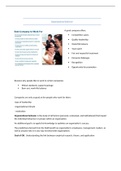Organizational behavior
A good company offers:
Competitive salary
Quality leadership
Work/life balance
Team spirit
Fair and respectful treatment
Personal challenges
Recognition
Opportunity for promotion
Reasons why people like to work in certain companies
Ethical standards, support package
Burn-out, work-life balance
Companies are only as good as the people who work for them:
-type of leadership
-organizational climate
- motivation
Organizational behavior is the study of all factors (personal, contextual, and institutional) that impact
the individual behaviour or groups within an organisation.
An additional goal is to apply this knowledge to optimize an organisation’s success.
The predictions derived from the field benefit an organisation’s employees, management, leaders, as
well as anyone who is in any way involved with organisations.
Goal of OB: Understanding the link between empirical research, theory, and application
,The doughnut Theory by Kate Raworth
The old idea states that a company should always try to generate growth. You start by putting money
and other inputs in and turn them into product output. Only, humans are more than just
inputs/machines. By doing this for years we are now pushing the limits of the earth.
Kate Raworth
suggested the idea
of a doughnut and
how to operate
within the
boundaries.
1.Change the goal
We cannot just
unconditionally grow; you
have to stay between the
boundaries
2. See the bigger picture
Don’t just focus on one company, but
on the whole economy.
Not all change works, not all change has positive consequences
We have ignored commons and households
Large and small groups can be equally successful.
3.Nurture human nature
Everything based on rational principles but the human nature isn’t self-oriented. Didn’t calculate the
altruistic aspect. You have to take the social adaptability into account.
4. Get Savvy with systems
,Not everything is a linear relationship. We assume that things are but that’s why mistakes in models and
systems are made.
5. Design to distribute
Distributing by design reboots the
system.
6. Create to regenerate
Way more recycling
7.Be agnostic about growth
Growth isn’t infinite.
There is only a limited
amount. Instead, try to
create a constant wealth.
Seeing the status of technology, it’s astounding that certain problems still can’t be solved. Think about
the Aral Sea.
Why OB?
Organizations are interesting: One of the only creatures that create organizations like we do. Not
unlike bees or other social insects who are ‘programmed’ to live like this.
Organizations are important: Success today, success tomorrow?
Organizational behaviour makes the difference :Organizations compete to be the best
Why do they exist?
An organization is an institution consisting of a coordinated group of people who cooperate together to
achieve a common goal
If the goal is to deliver a product or service, organizations can engage in division of labour, and
provide synergy.
o division of labor: everybody does what they are good at, this creates synergy
job performance is a function of attributes(of the people who work there), work effort and
organizational effort. The idea is to quantify this equation. Trying to measure job performance and put it
in terms of work effort and attributes
Dependent variables:
, o Productivity, ROI, ROA (financial)
o “Fortune 100” (legitimacy of organization): the more legitimate the organization, the
more people want to work there
o Absenteeism / Engagement (motivation): no motivation – lot of absence– problem
o Commitment (turnover): how often people quit, the higher the turnover the more
people quit
o Satisfaction / Job stress (success or failure): the more stress the less satisfaction
o Corporate Social Responsibility (people, planet, profit): : the more focus on the 3, the
more the company operates between the boundaries of the donut
Do these add up? Yes, but not all in the same proportions, we’re more
interested in the sum
Independent variables:
o biography: important,
demography(age, background,..)
o Perception: what you, your coworker
or employer perceive is different
o Communication: how and with what
means?
o Culture: the company culture must
match the individual culture
All these factors can
be mixed and one way or another they will influence the performance
There’s a multiplier effect here, if one of the 3 above is 0. You don’t get any job performance
• Goal: to investigate the relation between dependent and independent variables; obtain
knowledge by which to explain, predict and direct human behaviour.
• Problem: very few absolute “laws” in the social sciences; need for a contingency approach.
X leads to Y only when condition Z is met.
This is an example of an interactive effect of X and Y on Z//
Contingency approach is crucial. You have one variable (e.g. culture) this will influence the performance
but only when certain conditions are fulfilled. Organizational behavior can’t be predicted based on
individual behavior. Make a statement about performance and how big this influence will be
HR performance is a social exchange:
Contributions – What does the employee offer the organization? (The employees delivering their job)





